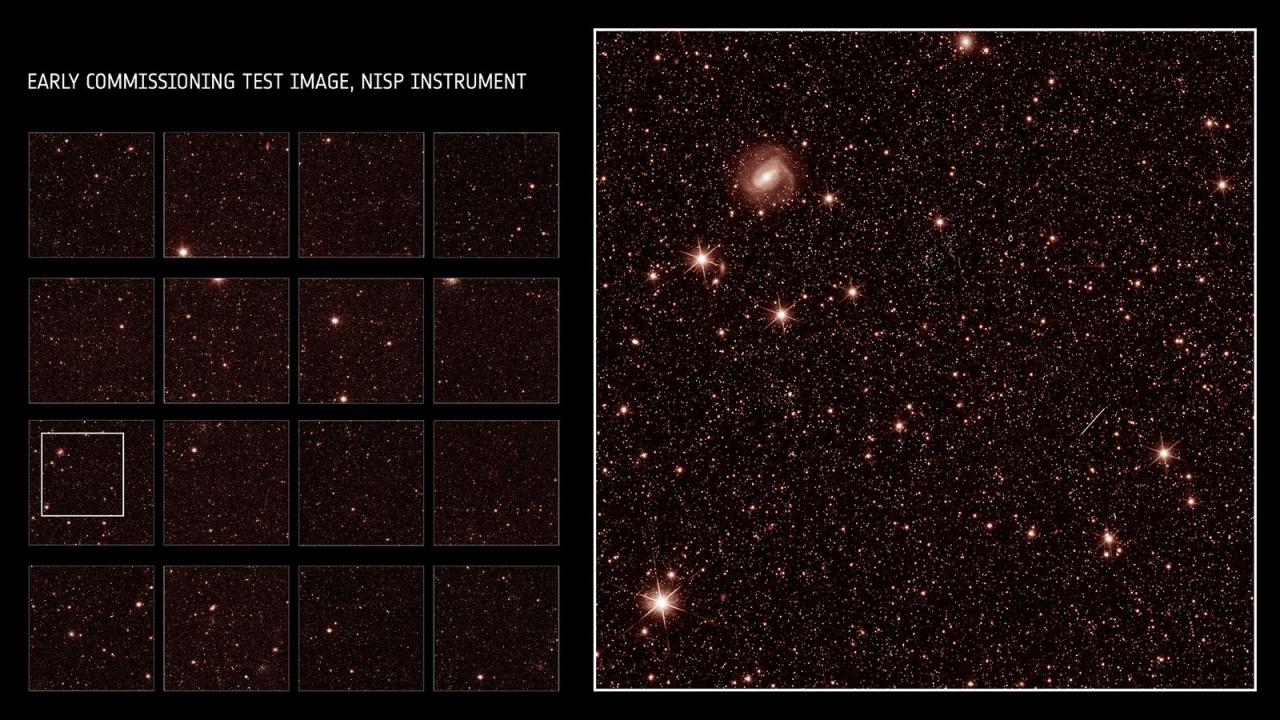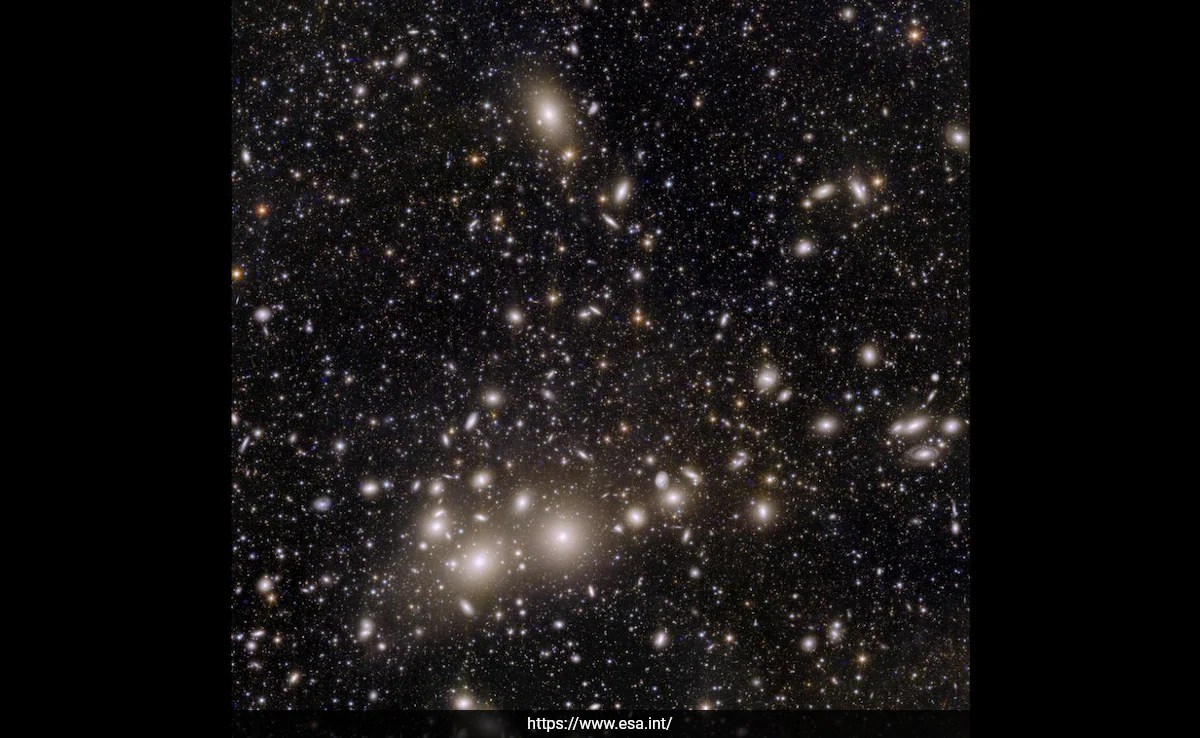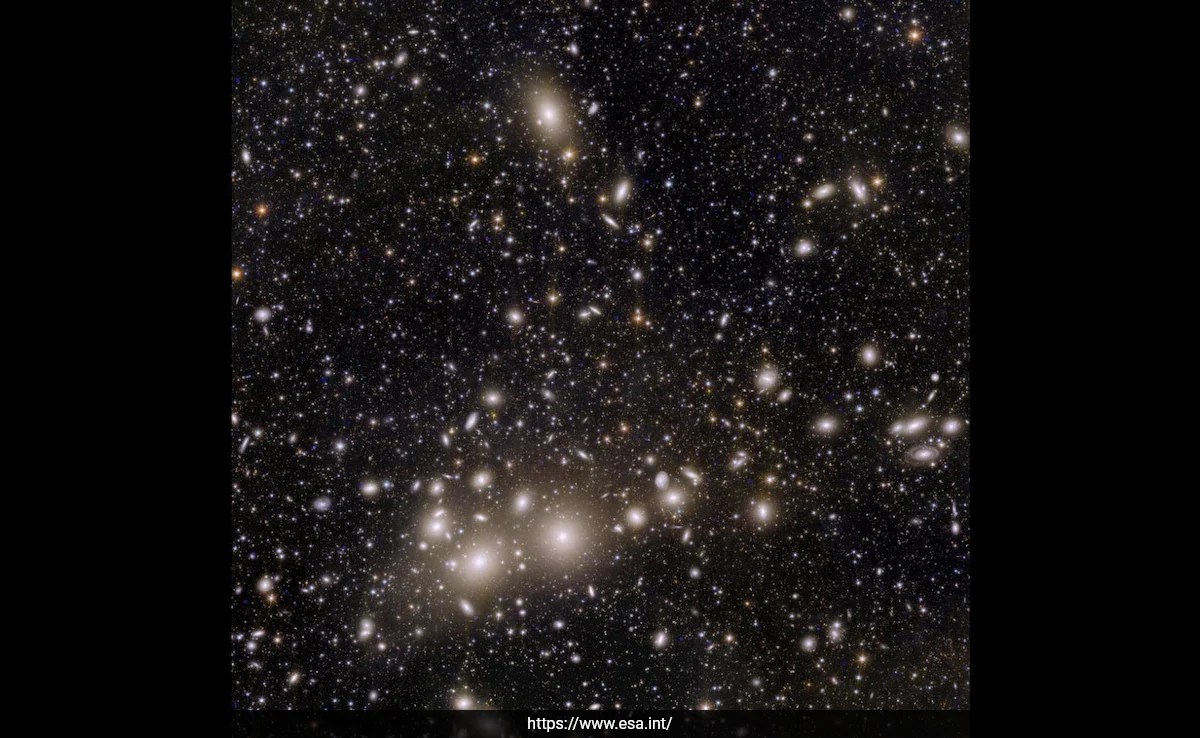Euclid telescope first images deep space – Euclid Telescope’s first images of deep space have arrived, offering a glimpse into the vast and mysterious universe. These images, captured by the powerful Euclid telescope, are not just stunning visuals but also a treasure trove of scientific data that promises to revolutionize our understanding of the cosmos.
The Euclid telescope, a joint mission by the European Space Agency (ESA) and NASA, is designed to study the distribution of dark matter and dark energy, the elusive forces that shape the universe’s expansion and structure. Its unique capabilities, including its wide-field camera and near-infrared spectrometer, allow it to capture images of distant galaxies and map the distribution of matter across vast cosmic distances.
Introduction to the Euclid Telescope

The Euclid telescope, a joint mission between the European Space Agency (ESA) and NASA, is a groundbreaking space observatory designed to unravel the mysteries of dark energy and dark matter, two elusive components of the universe that are believed to constitute the majority of its mass and energy.
By meticulously mapping the distribution of galaxies and the geometry of the universe, Euclid aims to provide crucial insights into the nature of these enigmatic entities and their influence on the evolution of the cosmos.
The Mission and Objectives
The Euclid telescope’s primary objective is to create a three-dimensional map of the universe, encompassing billions of galaxies spanning over 10 billion years of cosmic history. This map will serve as a powerful tool to investigate the distribution of dark matter and dark energy throughout the universe, revealing their impact on the expansion of space and the formation of large-scale structures.
Key Scientific Questions
The Euclid telescope is designed to address several fundamental questions about the universe, including:
- What is the nature of dark energy and how does it influence the expansion of the universe?
- How does dark matter distribute itself throughout the cosmos, and how does it affect the formation of galaxies and galaxy clusters?
- What is the geometry of the universe on large scales, and how has it evolved over time?
Unique Capabilities of the Euclid Telescope
The Euclid telescope possesses a unique combination of capabilities that make it an ideal instrument for studying the distribution of dark matter and dark energy:
- Wide-field imaging:Euclid’s primary mirror, measuring 1.2 meters in diameter, allows it to capture images of vast regions of the sky, enabling the observation of billions of galaxies over a wide range of distances.
- Near-infrared and visible light spectroscopy:Euclid’s instruments can analyze the light from distant galaxies, revealing their composition, redshift, and distance. This information is crucial for mapping the distribution of galaxies and understanding their evolution.
- High sensitivity:Euclid is designed to detect faint and distant galaxies, providing a comprehensive view of the universe’s structure and evolution.
The First Images from Euclid
The first images from the Euclid telescope, released in June 2023, represent a significant milestone in our understanding of the universe. They showcase the telescope’s remarkable capabilities, offering a glimpse into the vast expanse of space with unprecedented clarity and detail.
The Significance of the First Images
The first images from Euclid hold immense scientific significance, marking the beginning of a new era in cosmological research. These images, captured with unprecedented precision, provide a wealth of data that will help scientists address fundamental questions about the universe, including:* The nature of dark energy: Dark energy is a mysterious force that is thought to be responsible for the accelerated expansion of the universe.
Euclid’s images will help scientists map the distribution of dark energy throughout the cosmos, providing insights into its nature and properties.
Obtain a comprehensive document about the application of how to build a great software engineering team that is effective.
The evolution of galaxies
The images reveal a vast array of galaxies, offering a glimpse into their formation and evolution over billions of years. By studying the distribution and properties of galaxies, scientists can learn about the processes that shaped the universe we see today.
The distribution of dark matter
Dark matter is an invisible form of matter that makes up a significant portion of the universe’s mass. Euclid’s images will help scientists map the distribution of dark matter, providing insights into its nature and its role in the formation of galaxies.
Technical Challenges
Capturing these images presented significant technical challenges, requiring advanced technology and meticulous engineering:* Wide-field imaging: Euclid’s primary mirror is 1.2 meters in diameter, enabling it to capture vast swaths of the sky. This wide-field capability is crucial for mapping the distribution of galaxies and other celestial objects across large distances.
Precise pointing and stability
Euclid must maintain a remarkably precise pointing and stability, allowing it to capture images with minimal distortion. This is achieved through a sophisticated system of gyroscopes and star trackers.
Sensitive detectors
The telescope’s instruments are equipped with highly sensitive detectors that can capture faint light from distant objects. These detectors must be able to operate in the harsh environment of space, withstanding extreme temperatures and radiation.
Types of Celestial Objects
The first images from Euclid showcase a diverse range of celestial objects, including:* Galaxies: The images reveal a vast array of galaxies, both near and far, offering a glimpse into their diverse shapes, sizes, and colors. Some galaxies are spiral-shaped, while others are elliptical or irregular.
Clusters of galaxies
The images also capture clusters of galaxies, which are groups of hundreds or thousands of galaxies bound together by gravity. These clusters are important for studying the distribution of dark matter and the evolution of galaxies.
Stars
While not the primary focus of Euclid’s mission, the images also capture numerous stars, both within our own galaxy and in nearby galaxies.
Quasars
The images reveal distant quasars, which are incredibly bright objects powered by supermassive black holes at the centers of galaxies. Quasars are important for studying the early universe and the evolution of black holes.
Exploring the Universe’s Expansion and Structure

Euclid’s mission is a game-changer for our understanding of the universe. It’s not just about taking pretty pictures; it’s about unraveling the mysteries of dark energy and mapping the intricate distribution of matter across the cosmos. By combining these two, we can finally get a handle on the universe’s expansion and its grand, evolving structure.
Dark Energy’s Role in Cosmic Expansion, Euclid telescope first images deep space
The universe’s expansion is a well-established fact, but the driving force behind it remains elusive. Enter dark energy, a mysterious force that seems to be accelerating this expansion. Euclid’s observations are crucial for understanding dark energy’s role in the universe’s evolution.
Euclid’s observations are crucial for understanding dark energy’s role in the universe’s evolution. By mapping the distribution of galaxies over billions of years, Euclid will help us track how the expansion rate has changed over time. This information will provide vital clues about the nature of dark energy and its influence on the universe’s destiny.
Mapping the Distribution of Matter
Euclid’s data will be used to create a 3D map of the universe, charting the distribution of matter across vast distances. This map will reveal the intricate web-like structure of the universe, with galaxies clustered together in filaments and voids, and will provide insights into the gravitational forces that shape this structure.
- Euclid will measure the shapes and positions of billions of galaxies, revealing how gravity has distorted their light over billions of years. This technique, called weak gravitational lensing, allows astronomers to map the distribution of dark matter, which is invisible to telescopes but exerts a gravitational pull on visible matter.
- By combining data from galaxy surveys with observations of the cosmic microwave background radiation, the afterglow of the Big Bang, Euclid will create a comprehensive picture of the universe’s evolution and structure. This data will help scientists understand the interplay between dark matter and dark energy, two mysterious components that make up the majority of the universe’s mass and energy.
Unveiling the Mysteries of Dark Matter: Euclid Telescope First Images Deep Space
Euclid’s mission is not just about mapping the universe’s structure, but also about understanding the invisible force that shapes it: dark matter. While we can’t see dark matter directly, its gravitational influence is undeniable, affecting the motion of galaxies and the distribution of matter throughout the cosmos.
Euclid’s observations will help us study dark matter in unprecedented detail, shedding light on its nature and its role in the universe’s evolution.
Mapping Dark Matter Halos
Dark matter is thought to be distributed in vast, invisible halos around galaxies. These halos are much larger than the visible galaxies themselves, and their gravitational pull holds galaxies together and influences their motion. Euclid will map the distribution of dark matter halos by studying the weak gravitational lensing effect.
This effect occurs when the light from distant galaxies is bent by the gravity of massive objects, like dark matter halos, along its path to Earth. By analyzing the distortions in the images of distant galaxies, Euclid will be able to map the distribution of dark matter in the universe.
“Euclid will measure the weak lensing effect with unprecedented precision, allowing us to map the distribution of dark matter with a level of detail never before achieved.”
Identifying the Nature of Dark Matter
Euclid’s observations will also help us understand the nature of dark matter. By comparing the distribution of dark matter with the distribution of visible matter, scientists can learn about the properties of dark matter, such as its density and its interaction with other particles.
This information will be crucial in distinguishing between different theoretical models of dark matter, such as weakly interacting massive particles (WIMPs) and axions.
“Euclid’s observations will provide crucial data for testing different models of dark matter and ultimately help us understand the nature of this mysterious substance.”
The Future of Deep Space Exploration with Euclid
The Euclid telescope, with its ambitious mission to map the distribution of dark matter and dark energy, has already delivered stunning first images. These images are just the beginning of an exciting journey that promises to revolutionize our understanding of the universe.
As Euclid continues its observations, we can anticipate groundbreaking discoveries that will shape our view of the cosmos for years to come.
Ongoing and Future Observation Plans
Euclid’s mission is designed to span six years, during which it will meticulously map a vast portion of the sky. The telescope’s primary targets are galaxies located billions of light-years away. These distant galaxies provide a unique window into the universe’s evolution, allowing scientists to study how dark matter and dark energy have shaped its expansion and structure.
Euclid’s observations will be conducted in two primary modes:
- Wide Survey:This mode involves scanning large areas of the sky to create a comprehensive map of galaxies, revealing their distribution and clustering patterns.
- Deep Survey:This mode focuses on specific regions of the sky, providing more detailed information about the properties of galaxies and the distribution of dark matter within them.
By combining data from these two modes, scientists will be able to build a comprehensive picture of the universe’s evolution and the role of dark matter and dark energy in shaping it.
Anticipated Scientific Breakthroughs
Euclid’s observations are expected to lead to significant scientific breakthroughs, shedding light on some of the most fundamental mysteries of the universe.
- Precision Measurement of Dark Energy:Euclid’s observations will allow scientists to measure the properties of dark energy with unprecedented accuracy, helping to understand its nature and its influence on the universe’s expansion.
- Mapping the Distribution of Dark Matter:By observing the gravitational lensing effects caused by dark matter, Euclid will create detailed maps of its distribution throughout the universe. This will provide insights into the nature of dark matter and its role in galaxy formation.
- Testing Cosmological Models:Euclid’s observations will provide crucial data for testing different cosmological models, helping to refine our understanding of the universe’s history and evolution.
- Exploring the Early Universe:Euclid’s deep survey will allow scientists to study the universe in its earliest stages, providing insights into the processes that led to the formation of the first stars and galaxies.
Impact of Euclid’s Findings on Our Understanding of the Universe
Euclid’s findings are poised to have a profound impact on our understanding of the universe. They will provide crucial data for refining our current cosmological models and addressing fundamental questions about the nature of dark matter and dark energy. Euclid’s observations will also likely lead to new discoveries that challenge our current understanding of the universe.
By peering deeper into the cosmos than ever before, Euclid is poised to reveal hidden structures and processes that have shaped the universe we see today. The impact of Euclid’s findings will extend far beyond the realm of cosmology. They will have implications for our understanding of fundamental physics, particle physics, and even the nature of time and space itself.





